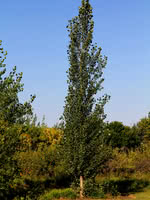Mon-Fri 9am - 5pm Mountain time
Common Hackberry vs Sundancer Poplar
Celtis occidentalis
Populus x ACWS151
The Common Hackberry is a medium-sized deciduous tree that resembles the American Elm but is immune to Dutch Elm Disease. They are versatile and can adapt to a variety of growing conditions.
It produces purple-red, berry-like fruit with a large seed in the center. Both the sweet flesh, which tastes similar to dates, and the crunchy seed are edible. The fruit remains on the tree throughout the winter, offering a valuable food source for birds and other wildlife.
The Common Hackberry can also be a great addition to a pollinator garden. The tree itself is a host for the larvae of several butterfly species and the flowers provide a source of pollen and nectar.
The Sundancer Poplar is a fast-growing, columnar hybrid that is resistant to Bronze Leaf Disease. Developed at the Agroforestry Centre in Indian Head, Saskatchewan, this cold hardy tree is well-suited to the Canadian prairies and northern regions.
Adaptable to various soil conditions and drought-tolerant once established, the Sundancer Poplar is an excellent choice for lining properties and roads or creating an attractive hedge.

